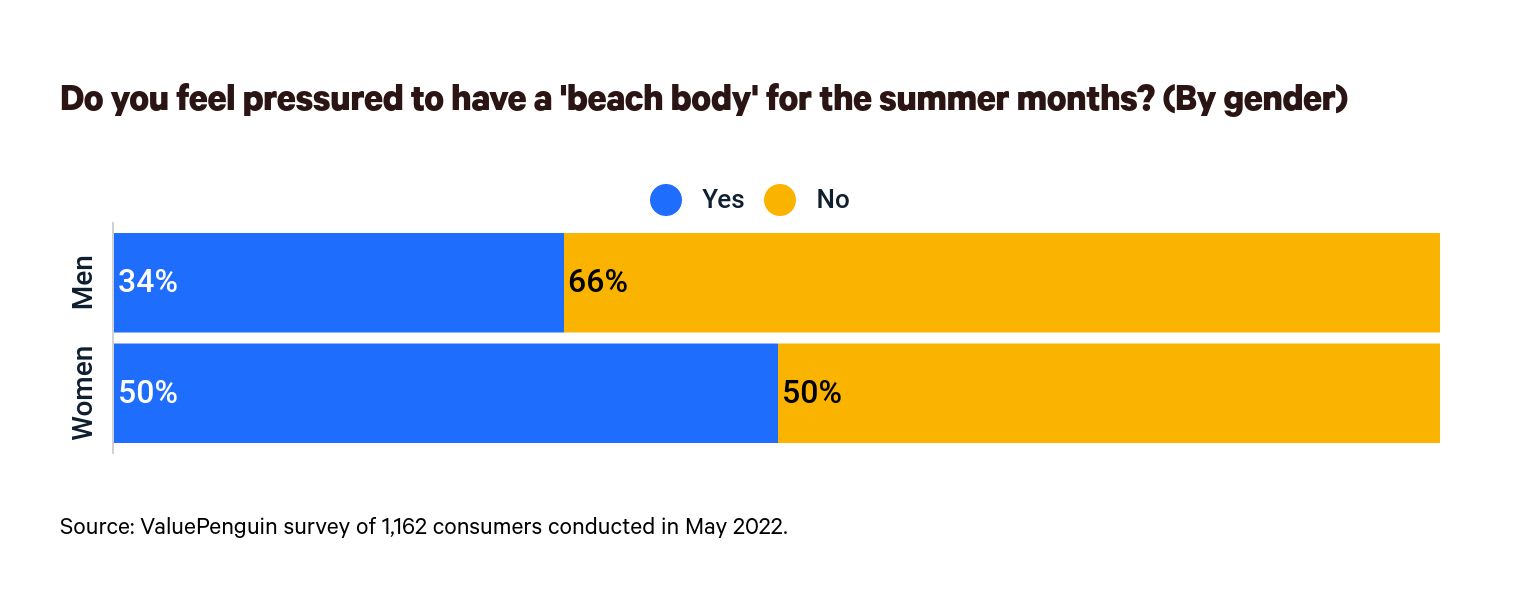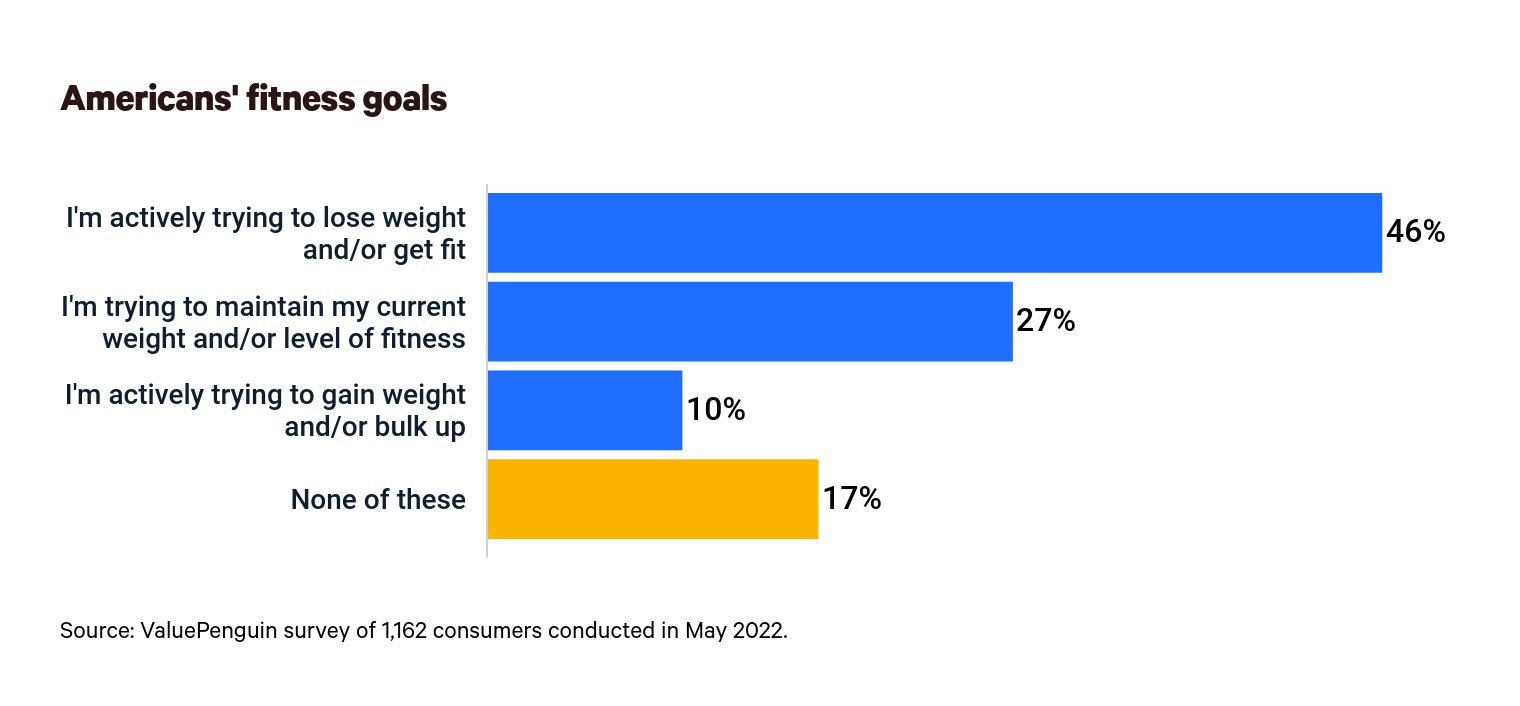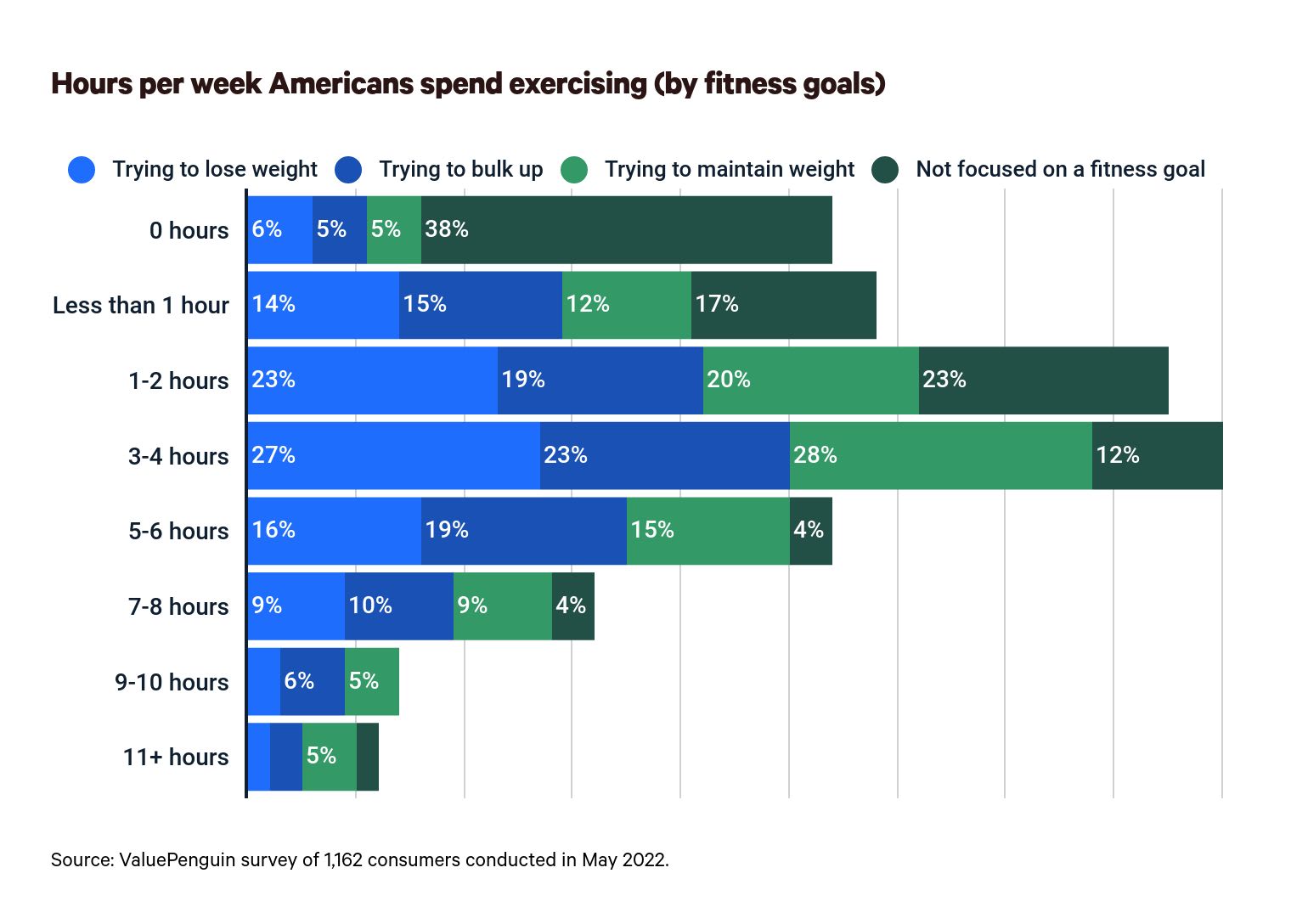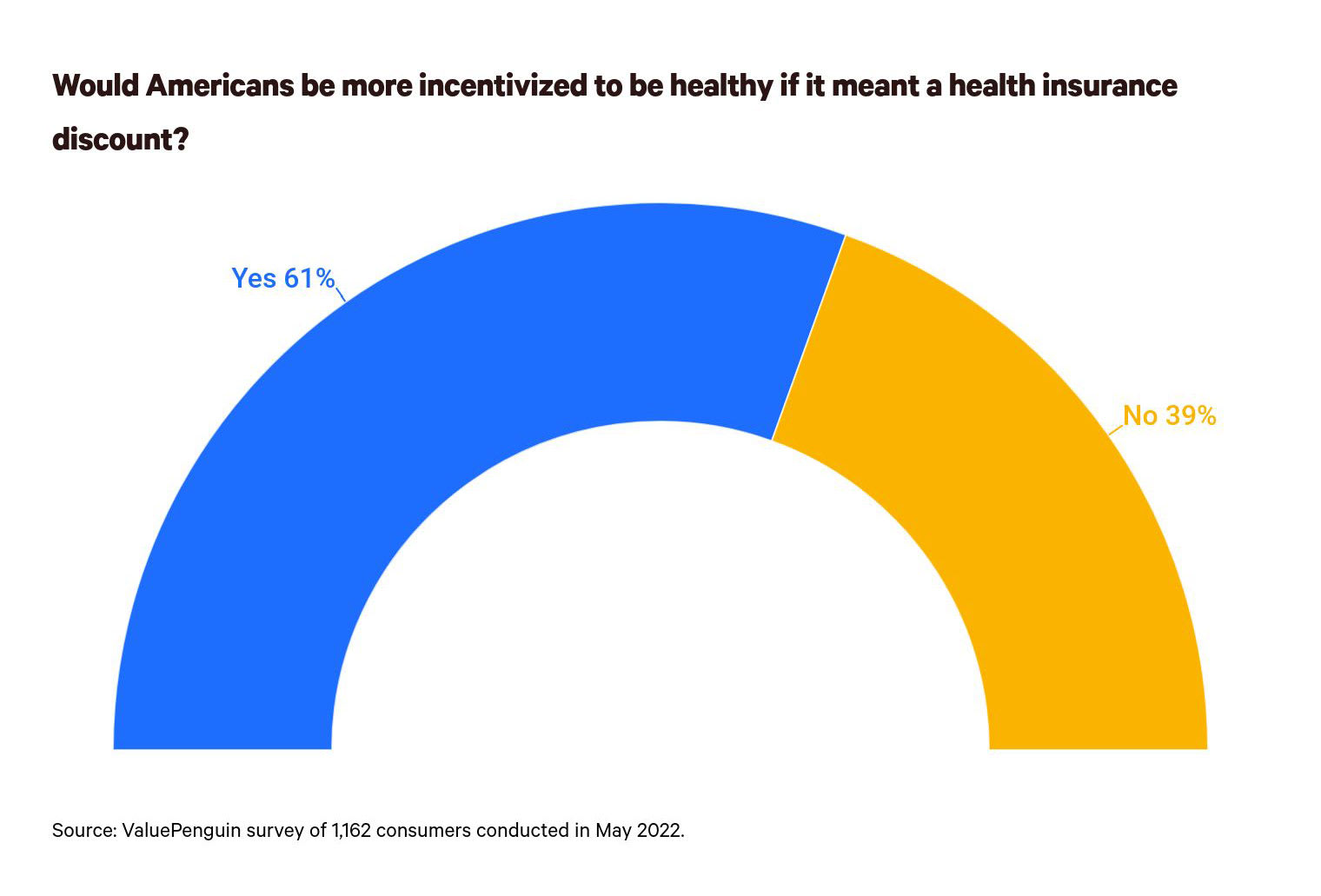Health Insurance
42% of Americans Feel Pressured to Have a 'Beach Body' for Summer

For many, summertime can be a season of beach activities and pool lounging. But as Americans start to shed some layers this summer, many feel pressured to shed pounds, too — and some even say they’re willing to go under the knife to achieve their perfect body.
In the latest ValuePenguin survey, we asked more than 1,100 consumers about their diet and exercise habits.
- Key findings
- Women feel the most pressure, but young men feel it, too
- Americans trying to lose weight may not have realistic goals
- Fitness is a (costly) lifestyle, yet few consider themselves fit
- 22% are willing to undergo cosmetic surgery
- Consumers want lower insurance rates, and some will lie to get them
- Top cost-effective health tips for this summer season
- Methodology
Key findings
- The summer heat is on, and so is the pressure to look good. 42% of Americans feel pressured to have a "beach body" during the summer. This surges to 75% among Generation Z women and 65% among millennial women.
- Nearly half of Americans (46%) are actively trying to lose weight, but are their expectations realistic? For example, half of those aiming for weight loss aren’t focused on nutrition and exercise, while a quarter of those with weight loss goals don’t visit their doctor for an annual checkup. Additionally, most of those looking to get fit for a specific event only give themselves six months or less to achieve their goals.
- Exercise is a critical part of fitness, but some consumers overlook its importance. 42% of those trying to lose weight spend less than three hours exercising each week, even though experts can recommend two-and-a-half to five hours.
- Some Americans would go beyond exercise and healthy eating to achieve their perfect body. 22% of Americans are willing to use cosmetic surgery to achieve their ideal body, which jumps to 36% among those who feel pressured to have a beach body and 32% among Generation X and millennial women. Specifically, 25% of Americans would consider, or have done, laser fat removal — making it the top cosmetic surgery choice among survey respondents.
- Consumers are willing to eat healthier and work out more if it comes with an insurance discount. 61% say they’d be more incentivized to be healthy (in terms of fitness and nutrition) if it translated to lower insurance costs.
Women feel most pressure to be fit in summer, but young men feel it, too
While more than 4 in 10 (42%) Americans feel pressured to get fit for the summer, the youngest generations are overwhelmingly more susceptible to the "beach body" mentality than their older peers. In fact, 71% of Gen Zers ages 18 to 25 feel pressured to have a beach body, followed by:
- 59% of millennials ages 26 to 41
- 30% of Gen Xers ages 42 to 56
- 19% of baby boomers ages 57 to 76
By gender, the feeling is most prevalent among women. Half of all women (50%) say they feel pressured to get fit this summer, with younger women leading the way. In fact, 75% of Gen Z women say they feel pressured, followed by 65% of millennial women.

Women feel the most pressure, but young men feel swimsuit stress, too. Though men (34%) are less likely to feel pressured overall, more than half of Gen Z men (59%) and millennial men (53%) say they feel pressured to have a beach body — the only other age groups over 50%.
Comparatively, for Gen X women — the next most likely group to feel pressured — just over a third (36%) feel similarly.
Americans trying to lose weight may not have realistic goals
Beach bodies aren’t the only reason consumers are trying to get fit. Overall, 46% of Americans are actively trying to lose weight. Gen X women (61%) are the most likely to be trying to lose weight, followed by millennial women (55%).

However, among those trying to lose weight, half (50%) aren’t focused on nutrition and exercise, which may prevent them from meeting their goals. Overall, more Americans are focused solely on changing their nutrition goals (29%) than the percentage focused solely on changing their exercise habits (21%).

Generally, men trying to lose weight are more likely to focus on exercise alone than women. Among Gen Z men — the group least likely to equally balance diet and exercise (25%) — 63% are focused solely on exercise, followed by 42% of millennial men. On the other hand, women trying to lose weight are typically more focused on their nutrition goals — especially among Gen X women, where 40% are focused solely on dieting.
Although some may focus on exercise more than they should, most Americans with weight loss goals may not be hitting the gym as much as they should. Experts can recommend two-and-a-half to five hours of exercise a week to achieve weight loss goals, but almost half (42%) of Americans with weight loss goals spend less than three hours exercising every week.

Additionally, a quarter (25%) of those with weight loss goals skip annual checkups with their doctors, which may be why unrealistic weight loss goals are common.
According to Robin Townsend, ValuePenguin health and life insurance expert, Americans who don’t get annual checkups could miss out on the guidance they need to develop balanced weight loss plans.
"You’re more likely to stick with a weight loss plan built around personal goals and health status, and a health care provider can help you develop a program to match your needs," Townsend says. "Your doctor can recommend a plan based on your health history, monitor your progress and make changes along the way."
22% of those getting fit for an event don’t give themselves enough time
Americans losing weight aren’t the only ones with unrealistic goals. This summer, 30% of respondents say they have an event or milestone for which they want to get fit, but some may not give themselves enough time.
Experts say it generally takes three to four months to notice significant changes after implementing a new fitness plan. While the majority (78%) of those getting fit for an event give themselves three months or longer to prepare, that leaves around a quarter (22%) who give themselves just two months or less.
Gen Xers are the least likely to give themselves enough time, with 25% giving themselves two months or less to get fit. Among Gen Zers, who are the most likely to be getting fit for an event this summer, 9% give themselves less than a month to do so — above the 5% average.
Fitness is a (costly) lifestyle, yet few consider themselves fit
Seven in 10 (70%) Americans believe that working out is more than just exercise — it’s a lifestyle. However, just 37% of Americans consider themselves fit.
Generally, Americans’ reasons for hitting the gym vary. Among those surveyed, 35% of Americans say they work out for the mental health benefits — making it the most popular reason for exercise. Gen Zers are the most likely group to exercise for the mental health benefits (40%), followed by baby boomers (38%).
Following mental health, Americans most often enjoy working out for solitude: 31% say they work out to spend time alone. It’s also the top reason among millennials (35%).
Fitness doesn’t come without a hefty price tag, either. On average, consumers spend $240 on fitness in a typical year. By age group, millennials spend the most — men in this range spend an average of $392, while women spend an average of $308.
Workout attire is the most common expense — 31% of consumers purchase clothing at least once a year, led by women (35%). The next most common fitness expenses are:
- A gym membership (28%)
- Workout equipment (21%)
- Workout classes (10%)
Gen Zers (39%) and men (31%) are more inclined to put money toward a gym membership. On the other hand, millennials (17%) and women (11%) tend to pay for workout classes more than any other group.
22% are willing to undergo cosmetic surgery
For some Americans, the pressure for a perfect body may include a quick fix.
When asked if they’d consider cosmetic surgery to achieve their ideal body, 22% of Americans say they would. That percentage jumps to 36% among those who feel pressured to have a beach body and 32% among both Gen X women and millennial women. Notably, 25% of Americans who consider themselves fit would consider cosmetic surgery, which is higher than the percentage of Americans who don’t think they’re fit but would consider it (20%).
Laser fat removal is the top cosmetic surgery choice among survey respondents. One in 4 (25%) Americans would consider, or have done, laser fat removal. That’s followed by:
- Abdominoplasty/tummy tuck (23%)
- Liposuction (23%)
Americans who feel pressured to have a summer beach body are particularly likely to consider the top cosmetic choices. In fact, 38% who feel pressured about a beach body say they would consider, or have done, laser fat removal. For tummy tucks, that percentage is 36%. Although liposuction falls slightly behind tummy tucks in popularity, 35% who feel pressured to have a beach body say they would consider it — 13 percentage points higher than average.
These cosmetic procedures come with hefty costs, too. Overall, Americans who’ve had at least one cosmetic procedure done spent an average of $2,400. Among Americans making $100,000 or more a year, that jumps to $5,063 — the most of any group surveyed.
Consumers want lower insurance rates, and some will lie to get them
As far as costs go, consumers say they’d like to see a change in their insurance rates, too. More than 6 in 10 (61%) say they’d be more incentivized to improve their fitness and nutrition if it translated to lower insurance costs.

Some consumers say they’ve even lied to get their insurance costs down. Among the 11% who say they’ve lied to their doctor or insurance provider, 30% say it was to qualify for the wellness rate — for men, that percentage jumps to 45%. Millennial men (52%) and Gen Z men (50%) are the most willing to lie for lower rates.
Notably, high earners are also more likely to lie for lower rates. Nearly half (47%) of those making $75,000 to $99,999 and 45% of those making $100,000 or more report that they’ve lied for that reason.
Townsend cautions against lying to a health care provider, as it can prevent you from receiving proper medical attention. It may even backfire. With treatable conditions going potentially undiscovered, lying may ultimately cause insurance rates to rise as conditions worsen. Instead, Townsend says the best thing you can do to lower your insurance rate is stay healthy.
"People at their ideal weight tend to be healthier and need fewer health services, which keeps insurance costs down," Townsend says. "Ideally, those cost savings are passed on to the consumer in the form of lower rates or added benefits."
Top cost-effective health tips for this summer season
Regardless of why you’re losing weight or changing your habits, getting fit can be cost-effective. Consider these tips to maximize the rewards of your health journey:
- Check what wellness incentives are offered to you. "Many employer-based and individual insurance plans offer wellness incentive programs, but you might not know of them unless you ask," Townsend says. Some insurers provide up to $500 in rewards for completing various health-related activities.
- Find workouts you enjoy. Working out may be essential, but it doesn’t have to be a necessary evil. Experiment with your workout routine until you find one that’s right for you, and consider motivating yourself with incentives and rewards. Additionally, fitness trackers may help you meet your workout goals. Another recent ValuePenguin survey found that smartwatch users tend to get more exercise than other people.
- Tell your doctor if you’re trying to lose weight. While it’s best to see your doctor at least yearly to catch health issues early on, it’s also important to let them know if you’re planning on losing weight. "A health care provider who knows your history can tailor a plan for your needs, which can significantly help you reach your goals," Townsend says.
Methodology
ValuePenguin commissioned Qualtrics to conduct an online survey of 1,162 U.S. consumers, fielded May 16-23, 2022. The survey was administered using a nonprobability-based sample, and quotas were used to ensure the sample base represented the overall population. All responses were reviewed by researchers for quality control.
We defined generations as the following ages in 2022:
- Generation Z: 18 to 25
- Millennial: 26 to 41
- Generation X: 42 to 56
- Baby boomer: 57 to 76
While the survey also included consumers from the silent generation (those 77 and older), the sample size was too small to include findings related to that group in the generational breakdowns.
